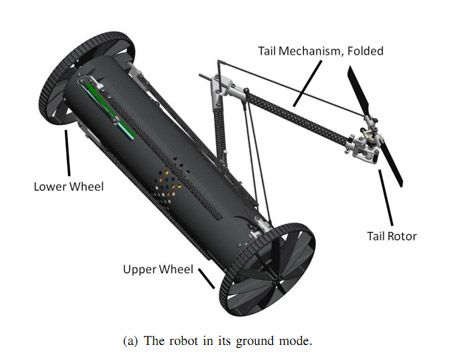Little Rolling Robot Transforms Into Helicopter
How do you get a ground robot over an obstacle? Just turn it into a helicopter
Designing a robot that can traverse variable terrain usually involves a number of unsatisfactory compromises. You can go with a flying robot, which will almost never get stuck, but is of limited use in detailed sensing and can't operate for very long. Or, you can go with a ground robot, which is much more efficient, but also much more likely to run into an obstacle that it can't get around.
An ideal platform would spend most of its time on the ground but still be able to fly when it needs to, but this is a very tricky thing to make happen, since the design of something that drives is fundamentally different from the design of something that flies. Researchers from the Center for Distributed Robotics at the University of Minnesota have managed to create a single robot that can actually do this effectively:
This is just the first (very fragile) prototype; the next version is much more robust and relies on a non-coaxial system for flight:
As it turns out, it was actually more efficient to design the robot with two completely independent motor systems than to try to design a transmission that would allow the low speed wheel motors to power the rotors or vice versa. And even then, it's still extremely complicated: the rotor folding mechanism cost almost US $20,000 to create. With that in mind, future developments for this platform will focus on making things simpler, while also teaching the robot to take advantage of its hybrid nature when it comes to autonomous path planning.
The researchers -- Alex Kossett and robotics professor and IEEE Fellow Nikolaos Papanikolopoulos -- describe their work in a paper, "A Robust Miniature Robot Design for Land/Air Hybrid Locomotion," presented yesterday at the IEEE International Conference on Robotics and Automation (ICRA), in Shanghai.
Evan Ackerman is a senior editor at IEEE Spectrum. Since 2007, he has written over 6,000 articles on robotics and technology. He has a degree in Martian geology and is excellent at playing bagpipes.
